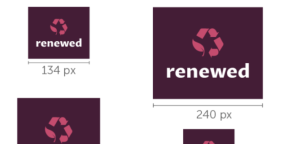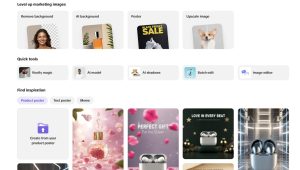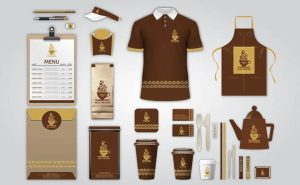Are you starting a new fitness business and looking for a way to stand out from the competition? One way to do this is by creating a unique color palette and logo design that accurately represents your brand. The right color scheme and logo can attract potential customers and help them remember your business.
According to scientific studies, colors can evoke emotions and feelings within people. This means that the colors you choose for your fitness brand can have a significant impact on how people perceive your business. For example, yellow is often associated with happiness and optimism, while purple is associated with luxury and sophistication. By choosing the right colors for your fitness logo, you can convey the message you want to send to potential customers.
Creating a fitness logo and color palette can seem daunting, but it doesn’t have to be. With the right tools and resources, you can create a unique design that accurately represents your brand. By working with a professional designer or using online resources, you can ensure that your logo and color scheme are visually appealing and memorable. With the right design, your fitness business can stand out from the competition and attract more customers.
Understanding the Fitness Industry
If you’re planning to design a logo for your fitness business, it’s important to understand the fitness industry and its current trends. This will help you create a logo that resonates with your target audience and stands out from your competitors.
Current Trends
The fitness industry is constantly evolving, and it’s important to stay up-to-date with the latest trends. Here are some current trends in the fitness industry:
- Personalization: Personalized fitness plans and experiences are becoming more popular as people look for customized solutions to their fitness goals. Your logo should reflect your business’s unique approach to personalization.
- Technology: Fitness technology is on the rise, with wearable devices, fitness apps, and virtual classes becoming more popular. Consider incorporating technology elements into your logo design to appeal to tech-savvy customers.
- Wellness: Wellness is becoming an increasingly important aspect of fitness, with more people focusing on mental and emotional health in addition to physical fitness. Consider incorporating wellness elements into your logo design to appeal to customers who prioritize overall well-being.
Target Audience
Your target audience will play a big role in your logo design. Understanding your target audience’s needs and preferences will help you create a logo that resonates with them. Here are some factors to consider when defining your target audience:
- Age: Different age groups have different fitness goals and preferences. Consider the age range of your target audience when designing your logo.
- Gender: Men and women may have different fitness goals and preferences. Consider the gender of your target audience when designing your logo.
- Fitness level: Beginners and advanced fitness enthusiasts may have different needs and preferences. Consider the fitness level of your target audience when designing your logo.
- Location: Your business’s location may influence the preferences and needs of your target audience. Consider the location of your target audience when designing your logo. With digital signage solution for gyms you can easily switch between different screens dedicated to all your locations.
By understanding the current trends in the fitness industry and your target audience’s needs and preferences, you can create a logo that effectively communicates your brand’s unique value proposition and resonates with your target audience.
Color Psychology in Fitness
Choosing the right color palette for your fitness brand is crucial as it can have a significant impact on how your audience perceives your business. Color psychology is a field of study that explores how colors affect human behavior and emotions. By understanding color psychology, you can create a fitness brand that resonates with your target audience and motivates them to take action.
Here are some of the most popular colors used in fitness branding and their associated meanings:
- Green: Green is often associated with nature, growth, and balance. It is a calming color that can help reduce stress and anxiety, making it a great choice for yoga studios and meditation centers.
- Blue: Blue is a calming color that can evoke feelings of trust, stability, and loyalty. It is often used in fitness branding to convey a sense of professionalism and expertise.
- Red: Red is a powerful color that can evoke feelings of passion, energy, and excitement. It is often used in fitness branding to convey a sense of intensity and motivation.
- Orange: Orange is a vibrant color that can evoke feelings of enthusiasm, creativity, and fun. It is often used in fitness branding to convey a sense of energy and excitement.
- Yellow: Yellow is a bright and cheerful color that can evoke feelings of optimism, happiness, and warmth. It is often used in fitness branding to convey a sense of positivity and encouragement.
- Purple: Purple is a color that can evoke feelings of luxury, creativity, and spirituality. It is often used in fitness branding to convey a sense of exclusivity and sophistication.
When choosing your fitness brand’s color palette, it’s essential to consider your target audience and the emotions you want to evoke. For example, if your target audience is primarily women, you may want to consider using shades of pink, purple, or blue, as these colors are often associated with femininity. If your target audience is primarily men, you may want to consider using shades of black, red, or blue, as these colors are often associated with masculinity.
In conclusion, color psychology is a powerful tool that can help you create a fitness brand that resonates with your target audience and motivates them to take action. By understanding the meanings behind different colors, you can choose a color palette that aligns with your brand’s values and goals.
Choosing the Right Colors for Fitness Logo
When it comes to designing a fitness logo, choosing the right color palette is crucial. The colors you choose can affect how your brand is perceived and can even influence a person’s mood. In this section, we will discuss the different color palettes you can use for your fitness logo.
Warm Colors
Warm colors are often associated with energy, passion, and excitement. These colors can help create a sense of urgency and can be great for fitness logos that want to motivate people to take action. Some warm colors you can consider for your fitness logo include:
- Red: Red is a powerful color that can evoke feelings of energy, strength, and passion. It can be a great choice for fitness logos that want to convey a sense of power and intensity.
- Orange: Orange is a warm and inviting color that can create a sense of enthusiasm and excitement. It can be a great choice for fitness logos that want to encourage people to take action.
Cool Colors
Cool colors are often associated with calmness, relaxation, and serenity. These colors can be great for fitness logos that want to create a sense of balance and harmony. Some cool colors you can consider for your fitness logo include:
- Blue: Blue is a calming color that can evoke feelings of trust, loyalty, and stability. It can be a great choice for fitness logos that want to create a sense of balance and harmony.
- Green: Green is a refreshing color that can evoke feelings of growth, health, and vitality. It can be a great choice for fitness logos that want to promote a healthy lifestyle.
Neutral Colors
Neutral colors are often associated with sophistication, elegance, and simplicity. These colors can be great for fitness logos that want to convey a sense of professionalism and simplicity. Some neutral colors you can consider for your fitness logo include:
- Black: Black is a powerful and sophisticated color that can evoke feelings of strength, power, and elegance. It can be a great choice for fitness logos that want to create a sense of professionalism and sophistication.
- White: White is a clean and simple color that can evoke feelings of purity, simplicity, and clarity. It can be a great choice for fitness logos that want to create a sense of simplicity and clarity.
When choosing your color palette, it’s important to consider your brand values and the message you want to convey. By choosing the right colors for your fitness logo, you can create a powerful and memorable brand that resonates with your audience.
Logo Design Principles
When it comes to designing a fitness logo, there are a few principles that you should keep in mind. A good fitness logo should be simple, versatile, and relevant to your brand. Let’s take a closer look at each of these principles.
Simplicity
Simplicity is key when it comes to designing a logo. A simple logo is more memorable and easier to recognize than a complicated one. Think about some of the most recognizable logos out there, like Nike’s swoosh or Apple’s apple. Both of these logos are simple, yet instantly recognizable.
When designing your fitness logo, aim for something that is bold and simple. Avoid fiddly bits and overly complicated designs. Keep in mind that your logo will need to look good on a variety of different platforms, from social media to merchandise.
Versatility
Your logo should be versatile enough to be used in a variety of different contexts. It should look good on everything from a business card to a billboard. This means that your logo should be scalable and easy to read at different sizes.
When designing your logo, consider how it will look in black and white as well as in color. A good logo should be recognizable even without color. You should also consider how your logo will look on different backgrounds and in different contexts.
Relevance
Your logo should be relevant to your brand and the fitness industry. It should convey the message that you want to send to your target audience. Think about the values that your brand represents and try to incorporate them into your logo.
Consider the colors, shapes, and fonts that are commonly associated with the fitness industry. For example, the color green is often associated with health and wellness, while the color red is associated with energy and passion. Incorporating these colors into your logo can help to convey the message that you want to send to your audience.
By keeping these principles in mind, you can create a fitness logo that is memorable, versatile, and relevant to your brand.
Incorporating Colors into Logo Design
When it comes to designing a fitness logo, colors play a crucial role in creating a strong brand identity. The right color palette can evoke emotions, set the tone, and convey the essence of your fitness brand. In this section, we will explore two essential aspects of incorporating colors into logo design: color harmony and color contrast.
Color Harmony
Color harmony refers to the pleasing combination of colors used in a logo design. A harmonious color palette can create a sense of balance and unity, making your logo visually appealing and memorable. Here are some tips for achieving color harmony in your fitness logo:
- Use complementary colors: Complementary colors are opposite each other on the color wheel, such as blue and orange or red and green. Using complementary colors in your logo can create a dynamic and eye-catching design.
- Stick to analogous colors: Analogous colors are adjacent to each other on the color wheel, such as blue, green, and yellow. Using analogous colors in your logo can create a harmonious and cohesive look.
- Use shades and tints: Shades are created by adding black to a color, while tints are created by adding white. Using shades and tints of the same color can create a subtle and sophisticated logo design.
Color Contrast
Color contrast refers to the difference between the colors used in a logo design. Contrast can create visual interest and help certain elements stand out. Here are some tips for achieving color contrast in your fitness logo:
- Use light and dark colors: Using light and dark colors in your logo can create a high contrast design that is easy to read and visually appealing.
- Use bold and muted colors: Using bold and muted colors in your logo can create a contrast between the foreground and background elements. This can help your logo stand out and make a lasting impression.
- Use color and grayscale: Using color and grayscale can create a contrast between the colored and non-colored elements of your logo. This can create a sophisticated and modern look.
Incorporating colors into your fitness logo design is an exciting opportunity to create a strong brand identity. By using color harmony and color contrast, you can create a logo that is visually appealing, memorable, and unique to your fitness brand.
Case Studies of Successful Fitness Logo and Color Palettes
When it comes to creating a successful fitness brand, the logo and color palette are crucial elements that can make or break your business. In this section, we will take a look at some real-world examples of fitness brands that have nailed their logo and color palette.
1. Nike
Nike’s iconic “swoosh” logo is instantly recognizable and has become synonymous with athleticism and performance. The logo is simple yet powerful, conveying a sense of movement and speed. Nike’s color palette consists of black and white, with occasional pops of red. This monochromatic approach gives the brand a sleek, modern look and allows the products to speak for themselves.
2. Under Armour
Under Armour’s logo features a stylized “UA” that resembles an interlocking shield. The shield represents protection and strength, while the “UA” stands for the company’s name. Under Armour’s color palette is primarily black, white, and gray, with occasional pops of red, blue, or green. This color scheme gives the brand a bold, edgy look that appeals to athletes and fitness enthusiasts.
3. Adidas
Adidas’s logo features three stripes that represent a mountain, symbolizing the challenges that athletes must overcome. The logo is simple and versatile, allowing it to be used in a variety of contexts. Adidas’s color palette is primarily black and white, with occasional pops of blue, green, or red. This color scheme gives the brand a classic, timeless look that appeals to athletes of all ages.
4. Reebok
Reebok’s logo features a stylized “R” that resembles an arrow, symbolizing forward motion and progress. The logo is simple yet dynamic, conveying a sense of energy and movement. Reebok’s color palette is primarily black and white, with occasional pops of red, blue, or green. This color scheme gives the brand a bold, modern look that appeals to fitness enthusiasts of all levels.
5. Lululemon
Lululemon’s logo features a stylized “A” that resembles a mountain, symbolizing strength and resilience. The logo is simple and elegant, conveying a sense of calm and balance. Lululemon’s color palette is primarily black and white, with occasional pops of pink, purple, or blue. This color scheme gives the brand a sophisticated, feminine look that appeals to yoga enthusiasts and active women.
By studying these successful fitness brands, you can gain insights into what works and what doesn’t when it comes to logo and color palette design. Whether you’re just starting out or looking to rebrand your fitness business, these case studies can provide valuable inspiration and guidance.
Conclusion
Congratulations! You now have a good understanding of how to choose the right colors for your fitness brand logo. By using the information provided by the search results, you can create a logo that will attract customers and help your business stand out from the competition.
Remember, your logo is the face of your brand, so it’s important to choose colors that accurately represent your business and appeal to your target audience. Keep in mind the emotions that different colors evoke and select colors that align with your brand’s personality and message.
When creating your logo, consider using bold and energizing colors like reds and blues, as well as grounding colors like grays and blacks. Use contrasting colors to make your logo pop and draw attention to your brand.
Additionally, consider the design of your physical space and how it can contribute to your brand identity. Use your chosen color palette in your gym’s decor and signage to reinforce your brand message and create a cohesive look.
By following these tips and using the information provided, you can create a powerful and effective logo for your fitness brand. Best of luck on your branding journey!
Angela Irwin is a branding and design enthusiast with a Bachelor of Fine Arts in Graphic Design from Meadowbrook College. As a writer at Logocreator.io, she shares her expertise on logo design, graphic trends, and effective branding strategies, helping businesses create impactful visual identities.



